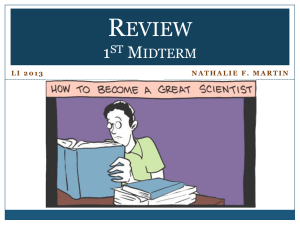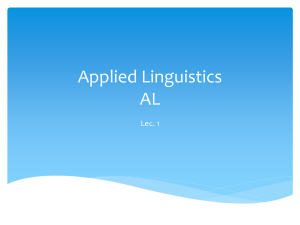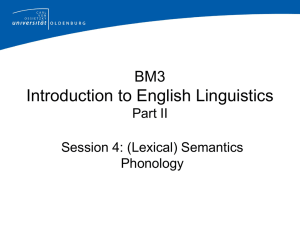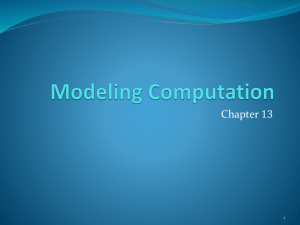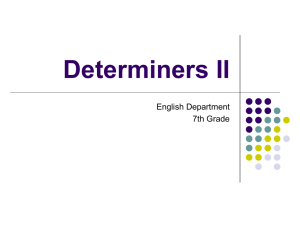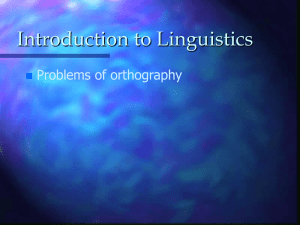Language & Grammar (review exercises for midterm)
advertisement
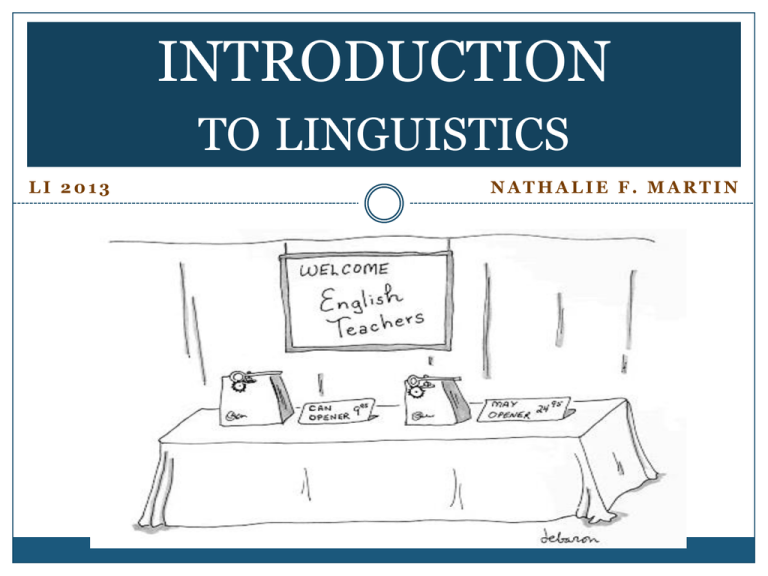
INTRODUCTION TO LINGUISTICS LI 2013 NATHALIE F. MARTIN What you should know: LANGUAGE: AN INTRODUCTION (chap. 1, O’Grady) How humans are made to speak What is language Linguistic competence vs. performance Descriptive vs. Prescriptive approach to language Grammar: Generality, parity, universality, mutability, inaccessibility LANGUAGE & COMMUNICATION Fill in the Blanks Communication Process (Jakobson) COMMUNICATION – Discussion WHO/WHAT CAN COMMUNICATE? WHAT DOES ONE (HUMAN OR NON HUMAN) NEED TO BE ABLE TO COMMUNICATE? WHAT IS LANGUAGE? DO ANIMALS HAVE LANGUAGE ABILITIES? Communication Communication is a behaviour, or the transmission of information, that affects the behaviour of others. When a living organism (or machine) communicates it sends messages about itself or its environment. The message is placed into a code. Humans have a highly elaborate code called language. Language, Dialect, Pidgin or Creole? 1. Language: 2. Dialect: 3. Variety: 4. Pidgin: 5. Creole: a. intergroup communication b. characterized by it’s own phonological, syntactic, or lexical properties c. A code or system used by consensus. d. native language deroved from a pidgin. e. A regional or social variety of a language. DIALECTS - Define Dialect: A regional or social variety of a language characterized by it’s own phonological, syntactic, or lexical properties. We will use the term « Variety » in this class instead of speaking of dialects. PIDGIN - Define Pidgin: A variety that emerges when speakers of a different language are brought together in a stable situation requiring intergroup communication; it has no native speakers and generally is considered to have a reduced grammatical system. Ex: Blood Diamond (Leonardo Dicaprio) http://www.youtube.com/watch?v=VP5ILgKxapI&feature=related http://www.youtube.com/watch?v=04QTfxGMe_Y CREOLE - Define Creole: A variety that arises as the native language of the children of members of a pidgin speech community. Language, Dialect, Pidgin or Creole? 1. Language: 2. Dialect: 3. Variety: 4. Pidgin: 5. Creole: a. Trade language b. Chiac c. Swahili d. Hatian e. African American Vernacular English GRAMMAR Language According to Linguists - Discussion EXPLAIN A LINGUISTS’ VIEW OF LANGUAGE AND GRAMMAR. Linguistic Competence Vs Performance Linguistic Competence: What you know about a language. Contemporary Linguistics Analysis: p. 5. Linguistic Performance: How you use this knowledge in actual speech production and comprehension. Prescriptive or Descriptive Grammar In Chiac French, the borrowed English verb is always conjugated as an “er” French verb. 2. In French negative sentences, we should always have “ne” + the verb + “pas” (ex: Elle ne veut pas) 3. In African American Vernacular English, some speakers pronounce the final sound of “sing” as an “n”. 4. Never say “ain’t” 1. a. DESC. b. PRESC c. DESC. d. PRESC. Prescriptive vs. Descriptive Grammar WHAT IS THE DIFFERENCE BETWEEN PRESCRIPTIVE GRAMMAR AND DESCRIPTIVE GRAMMAR? GRAMMAR PRINCIPLES GENERALITY: ALL LANGUAGES HAVE A GRAMMAR PARITY: ALL GRAMMARS ARE EQUAL UNIVERSALITY: GRAMMARS ARE ALIKE IN BASIC WAYS MUTABILITY: GRAMMARS CHANGE OVER TIME INACCESSIBILITY: GRAMMATICAL KNOWLEDGE IS SUBCONSCIOUS Reference: Chapter 1 (O’Grady & Archibald) The Truth About Grammar Contemporary Linguistics Analysis: p. 5. Name all five characteristics of grammar according to linguists. Generality: All languages have a grammar Parity: All grammars are equal Universality: Grammars are alike in basic ways Mutability: Grammars change over time Inaccessibility: Grammatical knowledge is subconscious Associate Generality: Parity: Universality: Mutability: Inaccessibility: Contemporary Linguistics Analysis: p. 5. • Grammars change over • • • • time. All grammars are equal. All languages have a grammar. Grammatical knowledge is subconscious. Grammars are alike in basic ways. Define each Generality: All languages have a grammar Parity: All grammars are equal Universality: Grammars are alike in basic ways Mutability: Grammars change over time Inaccessibility: Grammatical knowledge is subconscious Contemporary Linguistics Analysis: p. 5. What you should know: FIELDS OF LINGUISTICS (handout and Powerpoint) Linguistics Fields of linguistics (handout and in class) Descriptive linguistics Applied linguistics FIELDS OF LINGUISTICS THEORETICAL LINGUISTICS a. Computational b. c. d. e. linguistics Morphology Neurolinguistics Phonology Pragmatics APPLIED LINGUISTICS f. Psycholinguistics g. Semantics h. Sociolinguistics i. Syntax FIELDS OF LINGUISTICS THEORETICAL LINGUISTICS b) d) e) g) i) Morphology Phonology Pragmatics Semantics Syntax APPLIED LINGUISTICS a) Computational linguistics c) Neurolinguistics f) Psycholinguistics h) Sociolinguistics PHONETICS: A Brief Introduction (Handout and Powerpoint) What you should know: Sounds of English Consonants, vowels & glides IPA symbols general Consonants Phonetic Practice 1. Read these words phonetically and write them out using conventional English spelling. [mit] MEAT [ ʃuz] SHOES [skul] SCHOOL [mjuzɪk] MUSIC Phonetic Practice 2. Fill in the missing symbols. Cartoons =[ _ɑ__u__] Singing = [ _ ɪ _ ɪ _ ] English = [ɪ_ _ _ ɪ_] Cheese = [_ _ _ _ ] [kɑrtunz] [sɪŋɪŋ] [ɪŋglɪʃ] [tʃiz] IPA Consonants Examples IPA Vowels (examples) IPA Vowels (Diphthongs) IPA Glides (examples)

